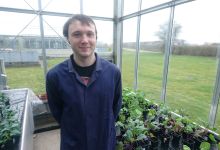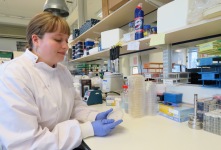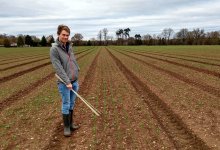Past PhD Student Projects based at Wellesbourne
Andy Gladman
Project Title: Investigating the interactions between biopesticides and partial crop resistance for management of aphid pests of Brassica crops
Funder: MIBTP

Aphid infestations in Brassica crops bear a huge economic burden upon growers, leaving produce unmarketable due to distortion of foliage, contamination of the crop and potential transmission of damaging viruses. Current field control measures rely heavily upon conventional chemical products, however with the emergence and dissemination of insecticide resistance in aphid populations alongside neonicotinoid withdrawal, growers have access to ever fewer control options.
This research aims to explore a novel IPM strategy utilising partial varietal resistance to retard aphid development and fecundity, thus enhancing the performance of entomopathogenic fungi (EPF) biocontrol agents. Currently EPF are inviable for aphid control due to the multiple phases of cuticle shedding during aphid development allowing for EPF spores to be shed prior to germination - rendering the EPF ineffective.
Candidate Brassica accessions, identified through the scientific literature and RNASeq analysis of a brassica diversity set for accessions with upregulated JA signalling pathway genes, will be screened in an infestation study to determine aphid survival and rate of development between accessions. Bioassays will then be undertaken with numerous EPF strains to determine their virulence and speed of kill against aphids in identified partially resistant Brassica accessions relative to known susceptible plants to quantify the viability and efficacy of this IPM approach.
Lisa King
Project Title: Understanding and Mitigating the Causes of Yield Decline in Pea
Funder: MIBTP and PGRO

The field pea (Pisum sativum) is an important legume grown for both human and animal consumption in over 110 countries worldwide. In the UK, growth is limited to areas within close proximity of processing facilities, which are situated across eastern England and Scotland. This has led to intensive production and yield declines of up to 40% in recent years, mostly attributed to a build-up of fungal and oomycete pathogens involved in the pea foot rot complex (PFRC). Important pathogens of the PFRC include Fusarium solani f. sp. pisi, Fusarium oxysporum, Aphanomyces euteiches and Didymella pinodella. Whilst initial research into the PFRC has consisted of field surveys, particularly in North America and Europe, to examine the prevalence, severity and identity of the pathogens involved, very little research has been conducted into the abundance, dynamics and interaction of these species within the complex, and crop rotation is currently the only disease management practice. Therefore, the aims of this project are to:
- Understand the components and dynamics of the PFRC as well as associated microbiota in the pea rhizosphere using both conventional and, in collaboration with the Processors and Growers Research Organisation (PGRO), amplicon sequencing approaches.
- Identify green manure and biofumigant crops that can suppress the PFRC.
Nicholas Kuht
Project Title: Enhancing salad onion quality and yield through understanding in-field variation
Funder: Waitrose CTP and G’s Growers

Salad onions are a high value UK vegetable crop consumed for their immature bulbs, green fleshy leaves and distinct flavour. Production is highly sensitive to a number of environmental, cultural and biotic factors that can affect the crop from seed germination to harvest maturity. Production of a uniform crop with little variation is key to attaining maximal marketable yields and economic returns for growers. In addition to the aforementioned factors, seemingly random patches of stunted salad onions have begun to be observed. The cause of this stunting though has yet to be identified and continues to be an issue for growers. This project aims to examine underlying variation in-field to elucidate different factors that influence salad onion variation and also to investigate the causative agents of stunting. The first year of this project was dedicated to mapping the variation that existed within commercial cropping, with the aim in the following three years being to investigate the causes of variation. The outcome from this research should be a greater understanding of the causes of variation, and it is hoped that recommendations can be provided to growers that will minimise their inputs and maximise returns.
